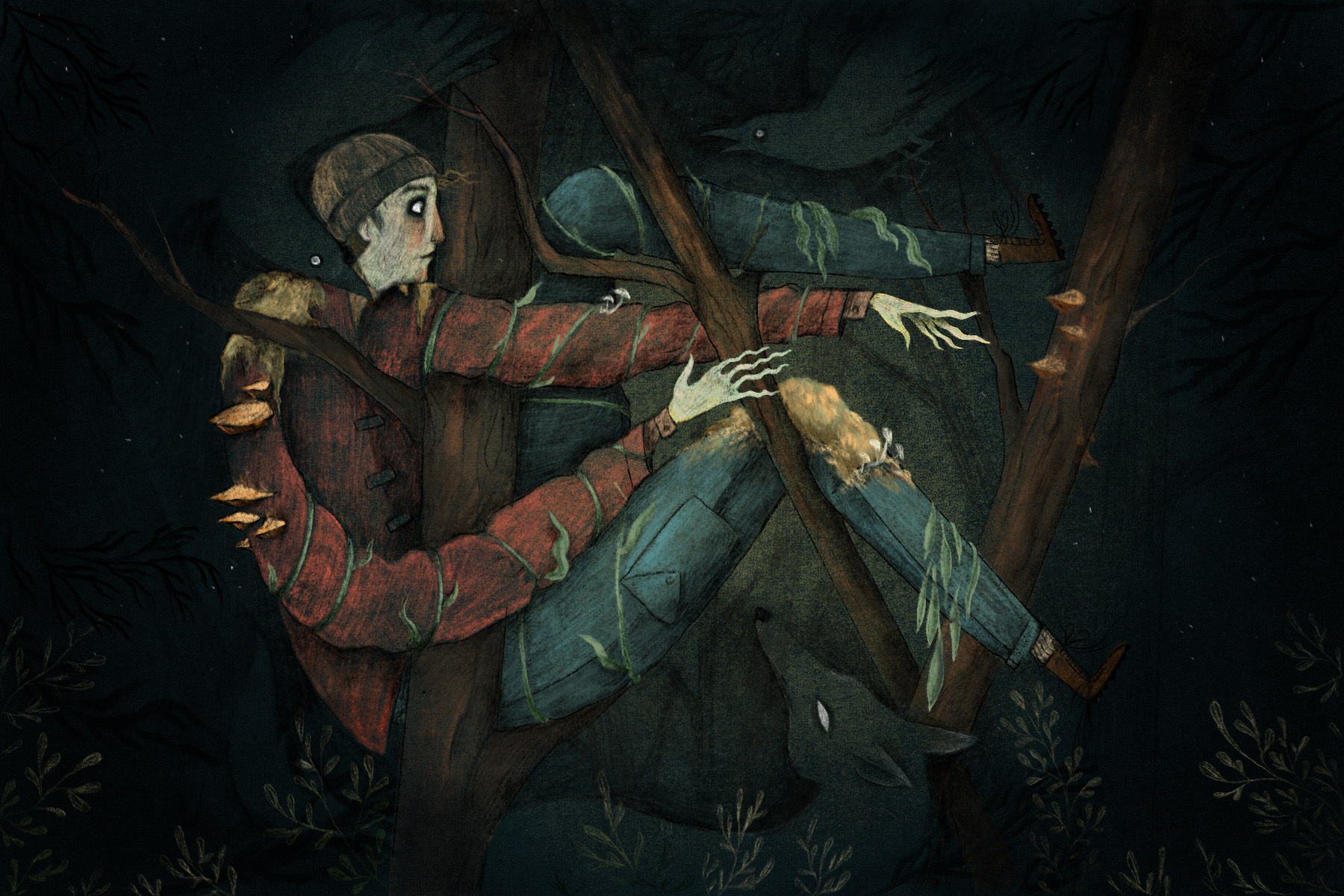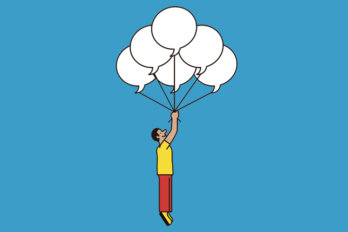A floating drone shot reveals a snow-blanketed forest next to rushing water. The icy chill can almost be felt through the screen, and it is clear that we are very much out in the wilderness. A man in a fluffy fur hat and big parka stands amongst trees equally fluffy from fresh snow. After seventy-eight days alone in northern Labrador, Juan Pablo Quiñonez is being interviewed about how emotional it has been to witness the slow march of winter freezing over the lake near his hand-constructed shelter. His voice cracks with emotion as he describes his goal of making it long enough to step out onto the ice as well as his longing to reunite with his partner. But she’s there, surprising him in the cold for the cameras, because he’s outlasted nine other contestants to win half a million dollars on a reality show that pits humans against both nature and one another in a test of endurance.
Forget about Survivorman, Naked and Afraid, or even the over-two-decades-old Survivor. Manitoban Quiñonez is a winner of the true heavy hitter of the genre, the one that is more popular than almost 99 percent of all reality shows in Canada, the “Olympics” of wilderness endurance: Alone. Ostensibly the ultimate wilderness survival challenge, History channel’s Alone allows contestants basic supplies and ten personal items, gives them cameras with which to record themselves, sends them out into the wilderness (since its premiere in 2015, seven of Alone ’s nine seasons have been filmed in Canada), and hopes for the best. Each person has a satellite phone which they can use to “tap out” if they can’t take it anymore, but whoever is the last one standing wins half a million dollars and bragging rights that come from being able to rely on skills so few of us seem to have. This isn’t sit-around-the-fire camping; this is survival.
Why watch? Is it the chance to witness incredible mental and physical struggles? We all know that human beings are a resilient bunch. It’s certainly fascinating to witness people concoct cabins, clothes, and a ukulele with nothing more than basic tools and bare hands. Beyond bushcraft, hunting and trapping is something that I can’t even imagine being able to do, and I’d also be hopeless if I needed to make a net to catch fish. But being an ace at these outdoor skills is rarely enough to keep contestants from running out of food and patience. The most skilled individual reaches a point where their survival skills are superseded by the reality of nature. It’s just too damned hard to be out in the bush living and doing everything totally and completely solo. We humans just aren’t good at this.
What has kept me watching from day one is not seeing who wins. No way. I’m not waiting for the last person standing. Rather, I yearn for each tap out. Every time, I’m given more insight into how human beings tick and what it means to accept that we might not be able to do it all by ourselves. Strategies among contestants vary, but they are all revelatory. They teach the viewer what it means to cope with being alone and show how survival is more about engaging with ourselves and one another than it is about triumphing against nature. Given the essential folly of lone living, as a viewer, it’s tempting to cheer for nature rather than the humans, who seem to consistently make errors in judgment.
A s pandemic restrictions recede and more people resume pre-COVID activities, loneliness remains a major threat in cities. Social distancing did exacerbate perceptions of isolation, but especially among city dwellers, loneliness has long been an environmental hazard. Ironically, the contestants in Alone might be best placed to tell us how not to be alone. A 2021 study demonstrated that high-density spaces correlate with loneliness, but that it could diminish with experiences of nature—be it forest or wildlife or open sky. Watching people try to survive on their own in the wilderness reminds us of our need for connection but also our need for the natural world.
Even though it’s only a television program, Alone demands that we pay attention to nature and its teachings—and perhaps those who are willing to take the time to recognize the importance of the land. Having grown up in Mexico and later moved to Canada, Quiñonez underlines that “going hiking and camping, it seems like a white thing, a privileged thing to do” and that it can seem “counterintuitive for those people that come from more challenging places to go back to the discomfort of being in the wilderness.” But he’s passionate about developing a relationship with nature for the sake of big issues—like the climate crisis. “Obviously it doesn’t matter where we come from, rich or poor, we all should have more nature, if not because of our health, but because we need to really listen to what nature needs because it’s our canary in our coal mine and we’re not listening.”
For me, the main character of Alone is the landscape itself—it’s nature that triumphs every time. Every season, the contestants travel to gorgeous spaces; Labrador, British Columbia, Northwest Territories, Mongolia, and Patagonia have all featured. The land is absolutely beautiful—rain or shine, hot or cold. But those who live there know this. Catherine Richardson is the director of First Peoples Studies at Concordia University. What she’s been told is that “when you grow up in the bush or whatever your community looks like and you’re Indigenous, the first thing you learn is to read the land. And there’s so many teachings, like when you leave the land, the land misses you, or if you go away for too long, the land doesn’t recognize you.”
As Quiñonez puts it, “So many people are around all these things that are built by humans. Then you start thinking that humans are the best thing ever. And that there’s nothing we can’t solve. But when you spend more time outside in things that are not made by humans, where there are all these different approaches by all the animals and plants, then you start to realize that you start to get a more holistic perspective.”
I t’s easy to slot this program into a tired (and colonial) “man against nature” trope that claims legitimacy through references to bushcraft and, specifically, Indigenous techniques—viewers learn about things like a Yup’ik fish trap from details that flash on the screen. Richardson is pretty clear that there is nothing Indigenous about the show, save for the need to gain permission to film on Indigenous land.
As she puts it plainly, “In the sense of living or being guided by Indigenous knowledges, we would never be out in the bush trying to survive and let others die. Like that concept of that individualism is so not Indigenous. If it was an Indigenous practice, they would be helping each other to survive just as a starting argument, right?” In addition, the land needs to, in Richardson’s words, “know your footprints.” That’s hardly possible when a person is dropped in for the sake of a reality show.
The idea of the rugged individual surviving in the bush runs counter to some fundamental knowledge about human nature. British anthropologist and evolutionary psychologist Robin Dunbar has researched the power of human connections, famously establishing 150 as the number of relationships that any individual can handle.
He’s not surprised that it is as much solitary existence as anything else that stumps the self-selected group of folks who have competed since the show first aired in 2015. As a society that has just experienced the psychological trauma of two years of pandemic lockdowns, solitude is not a foreign concept. “Survival on your own for any serious length of time isn’t exactly the easiest thing to do, even when you have bushcraft,” says Dunbar. As an expert in our primate cousins, he reminds us that even monkeys and apes who leave one community will try to find another group. He acknowledges that some people do enjoy being alone, but over the past thousands of years amongst human beings in Canada and anywhere else, the “biggest punishment you can put on anybody for behaving badly in the community is to throw them out of the group. That’s a death warrant.”
T he final three contenders of the most recently aired season, the show’s ninth, are incredibly engaging and enthusiastic about hanging out in nature. There’s Teimojin Tan, a doctor from Montreal, who placed third after wilderness skills instructor and energy medicine practitioner Idahoan Karie Lee Knoke and the aforementioned Quiñonez, author of Thrive, a long-term wilderness survival guide. Each acknowledged Alone ’s artifice: this is, of course, a TV show where the cast of characters has access to a full medical and evacuation team.
The challenge of Alone became a puzzle for Quiñonez. “How can I do that?” he asked himself in preparation. In Thrive, there are many how-to sections, but perhaps more interestingly, there are discussions of philosophy, approach, and training. “Nature is neutral,” he writes, and anyone planning on setting up camp out in the forest had best take this to heart.
Coming from the military, Tan spoke of how this prepared him to deal with failure. Around day forty, his approach was to develop a mission that would, in his words, “enable me to think for more than myself. The main inspiration was to hopefully connect my story and what I was doing out there with what my mom is going through,” as his mother was experiencing a difficult time. As her son, he wanted his performance on the show to assist her in “trying to get her life back in order and even feeling worthy enough to feel like she deserves that change in her life.”
“It was more important to tell a story that could inspire her,” he says, than it was for him to win the money.
Tan ponders the impetus for the show. The producers manufacture a situation where contestants have to test what works and what won’t. And lots of stuff just doesn’t work. “It comes to a point,” he says, “where there is such desperation or momentary lapses of incredible suffering that makes you so open to anything out there. . . . Whether that’s religion, spirituality, ancestors, spirits, and so forth. You become so open to the possibility of connecting deeper to the land or the universe in some way.”
And that was second-place finisher Knoke’s approach. Though she had always dreamed of living in the wilderness from the time she was a child, as an adult, she wanted to deeply and spiritually connect with the land. There was some sense of wanting to hide some of what she refers to as “woo woo,” but after a while, she let down her guard. “This is not serving anybody,” she recalls thinking, “I need to share with people what’s making me stay out here, what’s keeping me positive. And so I started recording the songs I was singing. I filmed one prayer.” Knowing the toll that exposure to the elements can take, the half-a-million-dollar prize was not worth her health, so when she noticed she was too weak, she tapped out.
Each of these approaches represents very human ways of dealing with stress. Every contestant speaks to the camera, and some, like Karie Lee, sing and play. Dunbar is not surprised. There’s a recipe for success—and perhaps we can see this as a recipe for success in our own lives. Things like singing, dancing, storytelling, and spirituality trigger the endorphin system. “Endorphins are part of the brain’s pain management system. That’s what they’re meant to do, but they operate as neurotransmitters in a large number of other contexts: turns out one of which is social bonding. And the effect they have is very similar to any other opioids.” The word comes from “endogenous morphine,” essentially the brain’s own morphine.
And they are free—which is convenient. To trigger their release, you just have to do something like singing, dancing, or storytelling. This makes me think of how music can magically affect my mood—and so can a good book or a TV show about people living in the woods. It also reminds me of how wonderful phone conversations and social events, even the online ones, felt like an exhilarating exit from the plodding norm of lockdown. Watching Quiñonez’s face light up as he sees his girlfriend after seventy-eight days alone reflects this excitement and reminds me of how wonderful it is to just connect with other people we care about.
Since the show finished, Tan’s had people reach out who are trying to mend relationships and get back in connection with people. Tan’s story is that of a need for connection. On the last day of his time alone, he carefully packed up all his possessions and pulled them through the powdery snow, all the while talking about his mother as well as his military comrades. Even alone, his thoughts were with others.





